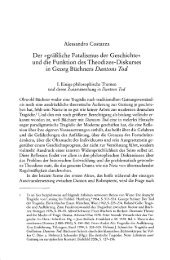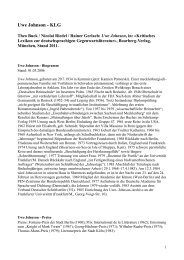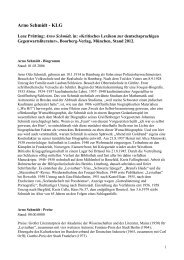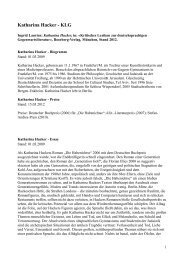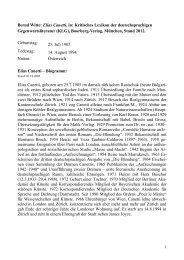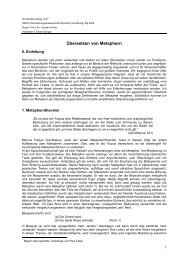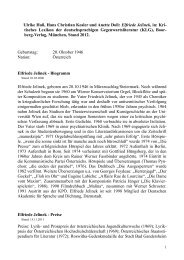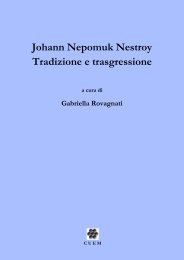Current Opinion in Investigational Drugs
Current Opinion in Investigational Drugs
Current Opinion in Investigational Drugs
Create successful ePaper yourself
Turn your PDF publications into a flip-book with our unique Google optimized e-Paper software.
34 <strong>Current</strong> <strong>Op<strong>in</strong>ion</strong> <strong>in</strong> <strong>Investigational</strong> <strong>Drugs</strong> 2006 Vol 7 No 1<br />
comb<strong>in</strong>ation of gabapent<strong>in</strong> and morph<strong>in</strong>e achieves a<br />
significant further reduction <strong>in</strong> pa<strong>in</strong> scores <strong>in</strong> a large<br />
majority of patients with neuropathic pa<strong>in</strong> [27•].<br />
Importantly, gabapent<strong>in</strong> has relatively m<strong>in</strong>or side effects<br />
and, as supported by the data from the available trials,<br />
withdrawal of treatment ow<strong>in</strong>g to side effects has not been<br />
significantly more common than <strong>in</strong> placebo groups. The<br />
numbers needed to harm (NNH) for m<strong>in</strong>or harm (tolerable<br />
adverse effects) was 3.7. The relative frequencies of adverse<br />
effects <strong>in</strong>cluded dizz<strong>in</strong>ess (24%), somnolence (20%),<br />
headache (10%), diarrhea (10%), confusion (7%) and nausea<br />
(8%) [18]. Dose titrations up to 3600 mg/day have been used<br />
<strong>in</strong> trials, although the maximum licensed dose <strong>in</strong> the UK is<br />
1800 mg/day. The available evidence suggests little<br />
potential for adverse <strong>in</strong>teractions with other agents.<br />
Although gabapent<strong>in</strong> exists at physiological pH as a<br />
zwitterion, and hence would be expected to exhibit limited<br />
permeability across membrane barriers, radiolabel<strong>in</strong>g<br />
studies have shown that it accumulates rapidly with<strong>in</strong><br />
neuronal cytosol [28]. This accumulation may be expla<strong>in</strong>ed<br />
by the carriage of gabapent<strong>in</strong> by system L am<strong>in</strong>o acid<br />
transporters, which operate across gut membranes [29] and<br />
neuronal and glial cell membranes [30]. This system<br />
becomes saturated at higher doses, which accounts for the<br />
non-l<strong>in</strong>ear relationship between oral doses and plasma<br />
concentration [29]. Gabapent<strong>in</strong> competes with am<strong>in</strong>o acids<br />
such as L-leuc<strong>in</strong>e, L-phenylalan<strong>in</strong>e and L-val<strong>in</strong>e at this<br />
transporter [30], although this is unlikely to be directly<br />
related to its mechanism of action [15].<br />
Gabapent<strong>in</strong> exhibits very little prote<strong>in</strong> b<strong>in</strong>d<strong>in</strong>g [31] and is<br />
excreted unchanged by the kidneys, with a first-order<br />
elim<strong>in</strong>ation pattern. Its plasma half-life is predictable and<br />
correlates with creat<strong>in</strong><strong>in</strong>e clearance [32].<br />
Anatomical site of action<br />
B<strong>in</strong>d<strong>in</strong>g sites for gabapent<strong>in</strong> are concentrated <strong>in</strong> the outer layer<br />
of the rat cerebral cortex [33] and <strong>in</strong> the superficial lam<strong>in</strong>ae of<br />
the dorsal horn [34••]. Peak anti-epileptic activity <strong>in</strong> rats occurs<br />
approximately 2 h after peak bra<strong>in</strong> <strong>in</strong>terstitial concentration<br />
[28]. The time course of ant<strong>in</strong>europathic activity after<br />
<strong>in</strong>trathecal <strong>in</strong>jection is similar [35], suggest<strong>in</strong>g that <strong>in</strong>traneural<br />
transport is prerequisite for both actions of gabapent<strong>in</strong>.<br />
In isolated slices of rat bra<strong>in</strong>stem, gabapent<strong>in</strong> <strong>in</strong>hibits<br />
substance P-mediated release of the excitatory neurotransmitter<br />
Figure 2. The structures of anti-epileptic drugs used to treat neuropathic pa<strong>in</strong>.<br />
O<br />
H<br />
N<br />
N<br />
H<br />
O<br />
N<br />
H N 2 O H N N<br />
2<br />
Cl<br />
Cl<br />
N<br />
N<br />
glutamate [36]. Furthermore, <strong>in</strong> vivo experiments have<br />
shown that gabapent<strong>in</strong> prevents the release of excitatory<br />
neurotransmitters, <strong>in</strong>clud<strong>in</strong>g glutamate, <strong>in</strong> sp<strong>in</strong>al cord<br />
microdialysate follow<strong>in</strong>g nociceptive stimulation by<br />
<strong>in</strong>traperitoneal acetic acid [37] or neuropathic pa<strong>in</strong> caused<br />
by sciatic nerve ligation [13].<br />
Possible mechanisms of action<br />
Does the mechanism of ant<strong>in</strong>europathic action of gabapent<strong>in</strong><br />
differ from its anti-epileptic action? Until both mechanisms<br />
are elucidated, we can <strong>in</strong>fer from the widely differ<strong>in</strong>g<br />
chemical structures of those anti-epileptic drugs that are<br />
used for neuropathic pa<strong>in</strong> (gabapent<strong>in</strong>, phenyto<strong>in</strong>,<br />
carbamazep<strong>in</strong>e, lamotrig<strong>in</strong>e, clonazepam and valproate;<br />
Figure 2) [10•] that it is unlikely that they all act at the same<br />
site. It would therefore be unlikely that all of these drugs<br />
each act at two dist<strong>in</strong>ct sites to produce two different, but<br />
common, effects; control of seizures and relief of<br />
neuropathic pa<strong>in</strong>. Given the relative specificity of these<br />
agents for neuropathic pa<strong>in</strong>, and the epileptiform activity<br />
observed <strong>in</strong> damaged sensory afferent fibers [5], it seems<br />
more plausible that both effects are mediated through a<br />
s<strong>in</strong>gle mechanism of action.<br />
Receptor-mediated actions<br />
Although gabapent<strong>in</strong> was orig<strong>in</strong>ally designed as an analog of<br />
the central <strong>in</strong>hibitory neurotransmitter GABA [9], no conclusive<br />
evidence has been found of a direct <strong>in</strong>teraction with any of the<br />
key receptors <strong>in</strong> central pa<strong>in</strong> transmission. Initial studies<br />
demonstrated that it has no direct agonist activity at GABA<br />
receptors [38] and does not b<strong>in</strong>d with high aff<strong>in</strong>ity to any<br />
GABA receptor subtype [39••]. More recent <strong>in</strong>vestigations<br />
us<strong>in</strong>g cloned receptors have found evidence of selective agonist<br />
activity at a subtype of presynaptic GABAB receptors on<br />
excitatory neurons [40•] (discussed below).<br />
Although D-ser<strong>in</strong>e, which acts as an agonist at the <strong>in</strong>hibitory<br />
glyc<strong>in</strong>e b<strong>in</strong>d<strong>in</strong>g site on N-methyl-D-aspartate (NMDA)<br />
receptors, reverses some of the actions of gabapent<strong>in</strong> [41], it<br />
has been shown that gabapent<strong>in</strong> itself does not directly<br />
<strong>in</strong>teract with the glyc<strong>in</strong>e-NMDA complex [39••,42] and<br />
gabapent<strong>in</strong> reduces downstream excitatory neurotransmitter<br />
release from rat bra<strong>in</strong> slices, even after NMDA receptorblock<strong>in</strong>g<br />
drugs have been adm<strong>in</strong>istered [43]. F<strong>in</strong>ally,<br />
gabapent<strong>in</strong> exhibits a profound synergistic anti-allodynic<br />
action with the AMPA receptor antagonist 6-cyano-7nitroqu<strong>in</strong>oxal<strong>in</strong>e-2,3-dione<br />
(CNQX) [35], suggest<strong>in</strong>g that the<br />
two drugs do not act at the same site.<br />
NH 2<br />
H<br />
N<br />
N N +<br />
O<br />
phenyto<strong>in</strong> carbamazep<strong>in</strong>e lamotrig<strong>in</strong>e clonazepam valproate<br />
O<br />
Cl<br />
O<br />
C<br />
H 3<br />
O<br />
OH<br />
CH 3




